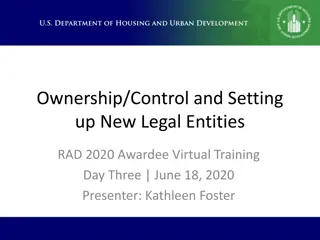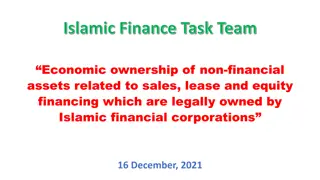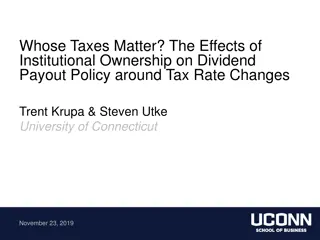
Equity & Ownership Basics Presented To: 2024 Berger Entrepreneur Bootcamp
Business entity selection basics including types, ownership, governance, liability protection, and tax treatment. Overview of sole proprietorship, general partnership, corporations, and limited liability companies. Introduction to securities transactions and regulations under the Securities Act of 1933.
Download Presentation

Please find below an Image/Link to download the presentation.
The content on the website is provided AS IS for your information and personal use only. It may not be sold, licensed, or shared on other websites without obtaining consent from the author. If you encounter any issues during the download, it is possible that the publisher has removed the file from their server.
You are allowed to download the files provided on this website for personal or commercial use, subject to the condition that they are used lawfully. All files are the property of their respective owners.
The content on the website is provided AS IS for your information and personal use only. It may not be sold, licensed, or shared on other websites without obtaining consent from the author.
E N D
Presentation Transcript
Equity & Ownership Basics Presented To: 2024 Berger Entrepreneur Bootcamp
Business Entity Selection Basics Entity Type* Ownership & Governance Liability Protection Tax Treatment Sole Proprietorship Owner controls all decisions. Unlimited Liability Obligations of business entity treated as obligations of owners Flow-through Taxation Entity not taxed; owners allocated pro rata portion of annual profits, reported on personal income taxes. General Partnership (2+ Owners) Each partner may bind partnership subject to partnership agreement. Unlimited Liability Joint and several liability for all partnership obligations Flow-through Taxation Distributions generally tax-free Corporations (C Corporation Tax Treatment) Board of directors (1+ director) ultimate governing authority, elected by shareholders (owners) Officers control day-to-day management Limited Liability Shareholders not liable for entity obligations beyond at- risk capital Double Taxation - Entity subject to corporate income tax and Shareholders subject to tax on dividend income Corporations (S Corporation Tax Treatment) Governance, same as C-Corp Ownership Limitations Maximum 100 shareholders; required US citizens/LPRs Single class of stock rule Limited Liability Flow-through Taxation Reasonable comp of shareholder- employees subject to income tax Distributions generally tax-free Limited Liability Companies (LLCs) Flexible governance; most states allow management by member(s) (owners) or manager(s), subject to operating agreement. Limited Liability Check-the box selection for Flow-through taxation (disregarded entity/partnership), S Corporation, or C Corporation *Please note the above descriptions are based on general concepts common across multiple jurisdictions. Specifics for each entity type are governed by applicable state and tax law, and are not covered by this presentation.
Securities Transactions The Basics Section 5, Securities Act of 1933 Section 5 of the Securities Act of 1933, as amended (Securities Act), requires all offers and sales of securities to be registered with the Securities and Exchange Commission (SEC) unless there is an available registration exemption. What is a Security ? - Section 2(1) any note, stock, treasury stock, security future, security-based swap, bond, . . . or, in general, any interest or instrument commonly known as a security , or any certificate of interest or participation in, temporary or interim certificate for, receipt for, guarantee of, or warrant or right to subscribe to or purchase, any of the foregoing. Section 2(1) of the Securities Act of 1933, Pub. L. 86 70, 12(a), codified at 15 U.S.C. Section 77b(a)(1)
Securities Transactions The Basics, contd Most common exemptions: Section 4(a)(2) of the Securities Act, which exempts from registration transactions by an issuer not involving a public offering. Rule 506 of Regulation D, which provides safe harbor exemptions under Section 4(a)(2) for private placements that meet specified objective standards. Section 4(a)(2) Issuer Private Placements & Safe Harbors Rule 504 (under Section 3(b)(1)). Rule 506(b) (supplement to Section 4(a)(2)). Rule 506(c) (supplement to Section 4(a)(2)). Offering Features - Investor suitability, Limited number of investors, Prohibition on general solicitation and general advertising, Information requirement, Transfer restrictions on Restricted Securities , Investment intent, Integration with other offerings Rule 10b-5 Anti-Fraud Rules Private Civil Cause of Action & SEC Criminal Enforcement it shall be unlawful for any person . . . (a) [t]o employ any device, scheme, or artifice to defraud, (b) [t]o make any untrue statement of a material fact or to omit to state a material fact . . . or (c) to engage in any act, practice, or course of business which operates or would operate as a fraud or deceit upon any person, in connection with the purchase or sale of any security.
Regulation D Requirements Rule 504 Rule 506(b) Rule 506(c) Maximum size of offering $5 million (in aggregate with all securities sold under Section 3(b)(1) or in violation of Section 5(a) of the Securities Act) per year. No limit on size of offering. No limit on size of offering. Issuers permitted to rely on this exemption Non-reporting companies; non-investment companies (as defined in the Investment Company Act of 1940, as amended (ICA)), nor blank check companies. Any issuer. It can be used by both reporting companies and non-reporting companies. Any issuer. It can be used by both reporting companies and non-reporting companies. "Bad actor" disqualification Bad actor disqualification by reference to Rule 506 bad actor disqualification. Certain Criminal Convictions (5-10 years old) Court Injunctions (5 years old) SEC Administrative Orders (5 years old) State Securities Regulator Orders Security Industry Bars, Suspensions, Expulsions Unlimited accredited investors and up to 35 non-accredited investors (must be sophisticated investors). Same Types of investors that can buy the securities Any investor. No limits on number or sophistication of investors. Unlimited accredited investors. Limitations on resale of securities? Yes, subject to the exceptions provided by Rule 504(b)(1). Yes. Yes. Yes. Yes. Yes. Form D filing? No. Yes. Yes. State law (blue sky) registration and qualification requirements pre- empted?
Basics of Corporate Equity Common Stock Residual class of owners; beneficially own corporate assets after obligations repaid Elect directors, participate in shareholder voting on per-share basis Founders issued shares at incorporation for nominal value Preferred Stock Negotiated financing by early-stage company investors Minority ownership position based on enterprise value Convert into common stock (conversion price, subject to adjustment) Carry enhanced rights: liquidation preference, anti-dilution, special protective provisions, board appointment rights, preemptive rights, and others Equity Incentive Shares Defined pool of equity Issued subject to incentive plan Equity often awarded as stock options, requires payment of exercise price. Employees may receive ISOs (incentive stock options) up to $100k Tax law requires exercise price not less than FMV of one share of common stock May be subject time or milestone-based vesting and mandatory repurchase rights Convertible Securities Convertible Notes, SAFEs, KISSes, Warrants
Firm Life Cycle and Financing Other Forms of Financing Bridge Financing Venture debt Traditional loan plus equity warrant coverage Crowdfunding Start-Up Accelerators Funding, training and support for fixed duration, post-product phase Start-Up Incubators and Venture Studios Funding, training and support for indefinite time during product development. Source: National Venture Capital Association, 2020 Yearbook






















